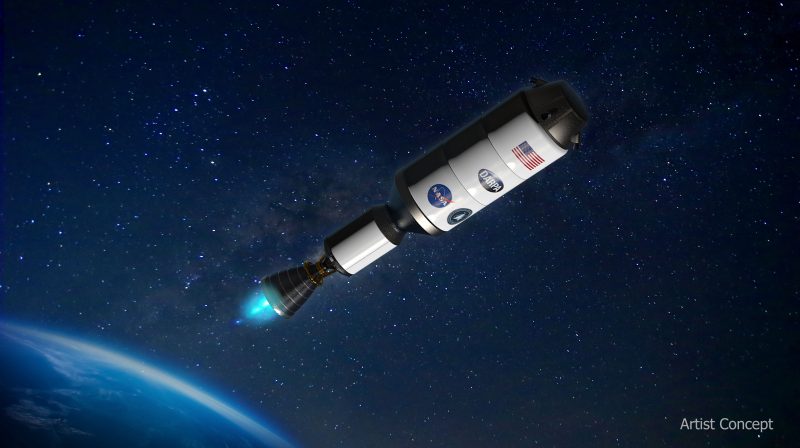NASA and DARPA will build a nuclear rocket to Mars. An uncrewed prototype could launch as early as 2027, they said.
Nuclear rocket to Mars demo by 2027
U.S. military and space agencies said on Tuesday, January 24, 2023, that they want to build a high-speed nuclear rocket to carry humanity into deep space. Their focus is on speed and high velocity: a fast-track program to build a quicker spaceship. And they’re making the rocket’s development an immediate priority. A demonstration mission could fly to Mars within four years.
NASA administrator Bill Nelson, speaking at the American Institute of Aeronautics and Astronautics SciTech Forum in National Harbor, Maryland, said the world’s first nuclear thermal rocket (NTR) could make its maiden voyage as soon as 2027. The Defense Advanced Research Programs Agency (DARPA) will be NASA’s main partner in realizing the somewhat audacious plan. Nelson described the project’s main goal:
NASA will partner with our longtime partner DARPA to develop and demonstrate advanced nuclear thermal propulsion, a revolutionary technology that will allow the United States to expand the possibilities for future human space flight missions.
Nuclear rocket to Mars!
The partnership is actually an extension of DARPA’s Demonstration Rocket for Agile Cislunar Operations (DRACO) program. The aim is to build an NTR with greater power than the current industry-standard chemical rockets.
NASA is throwing its weight behind the effort with an eye toward putting humans on Mars. Administrator Nelson explained:
Nuclear thermal propulsion is much more powerful, with two to five times the efficiency of chemical propulsion. And with the help of this propulsion system astronauts will be able to journey to and from deep space faster than ever, a major capability to prepare for crewed missions to Mars.
An NTR creates power by heating its fuel – usually liquid hydrogen – inside a nuclear reactor before expelling it into space. This advantage results in faster flights with bigger payloads.
DARPA puts it this way:
NTRs use a nuclear reactor to heat propellant to extreme temperatures before exhausting the hot propellant through a nozzle to produce thrust. Compared to conventional space propulsion technologies, NTRs offers a high thrust-to-weight ratio around 10,000 times greater than electric propulsion and two-to-five times greater specific impulse (i.e., propellant efficiency) than in-space chemical propulsion.
The wonks at NASA say such power means trips to Mars in 100 days or so.
DARPA running the show
While today’s announcement came from the head of NASA, the program will be under control of DARPA. A press release from NASA accompanying Nelson’s address makes clear it’s really DARPA doing most of the heavy lifting:
Under the agreement, NASA’s Space Technology Mission Directorate (STMD) will lead technical development of the nuclear thermal engine to be integrated with DARPA’s experimental spacecraft. DARPA is acting as the contracting authority for the development of the entire stage and the engine, which includes the reactor. DARPA will lead the overall program including rocket systems integration and procurement, approvals, scheduling, and security, cover safety and liability, and ensure overall assembly and integration of the engine with the spacecraft.
For its part, DARPA wants to tap NASA’s expertise from decades of handling liquid hydrogen on its missions. DARPA’s press release quoted DRACO program manager Dr. Tabitha Dodson:
NASA is uniquely positioned to provide guidance on the challenging rocket engine and cryogenic fluid management specifications with liquid hydrogen to meet specific mission needs. Since the NTR uses propellant more efficiently, it offers more aggressive trajectories and creative burn profiles to move heavy cargo more quickly in the cislunar domain as compared to today’s in-space propulsion methods.
Nuclear rockets aren’t new
This isn’t the first time US space agencies have dabbled in nuclear-powered rocketry. NTRs were first tested practically half a century ago during the Space Race, but they never left the ground. DARPA said this time will be different:
Nuclear thermal rockets have been built before, so DRACO has a head start. About 50 years ago, the technology was tested on the ground. DRACO is now leveraging lessons learned from past NTR reactor technology, but instead of using highly-enriched uranium, DRACO is using high-assay low-enriched uranium (HALEU) fuel to have fewer logistical hurdles on its ambitious timeline. As an added safety precaution, DARPA plans to engineer the system so that the DRACO engine’s fission reaction will turn on only once it reaches space.
The suddenly renewed interest in nuclear-powered spaceflight actually isn’t so sudden. The technology, with its greater potential for power, has simmered on the back burner for decades. Then in 2019 the US Congress turned up the heat, providing a $125 million funding block for development of an NTR engine.
Coincidentally – or perhaps not – 2019 was also the last year NASA Administrator Bill Nelson served as a senator from Florida, capping a 40-year career in politics. He was the ranking Democratic member of the Senate Committee on Commerce, Science and Transportation and was previously the chair of the Subcommittee on Science and Space.

Bottom line: NASA and DARPA will build a nuclear rocket to Mars. An uncrewed prototype could launch as early as 2027, they said.











